In this lesson, you will learn how to combine chords with a walking bass line, a concept that is becoming more and more in demand these days. As club and restaurant owners are cutting budgets, one way to keep our gig as a guitar player is to slim down the ensemble to a duo or solo.
A walking bass line walks through the chord progression, one note per beat. Its function is to outline the chords of the progression and provide a smooth transition from one chord to another.
While walking bass in a band is generally played by the bass guitar or double bass player, being able to play walking bass lines is an essential skill for jazz guitarists when playing without a bass player.
The difficulty in walking bass on the guitar lies in the combination of playing chords and bass at the same time.
Walking bass on guitar is usually played fingerstyle. Use your thumb for the bass notes and your other fingers to comp the chords.
In this lesson, you will learn how to write and play a walking bass line over a 12-bar blues in F.
Being able to walk a bass line and comp the chords at the same time is an invaluable skill to have and one that will allow you to work in situations where other guitarists cannot.
Table of Contents
Video – Jazz Blues Walking Bass
Drum Backing Track
Listen & Play-Along
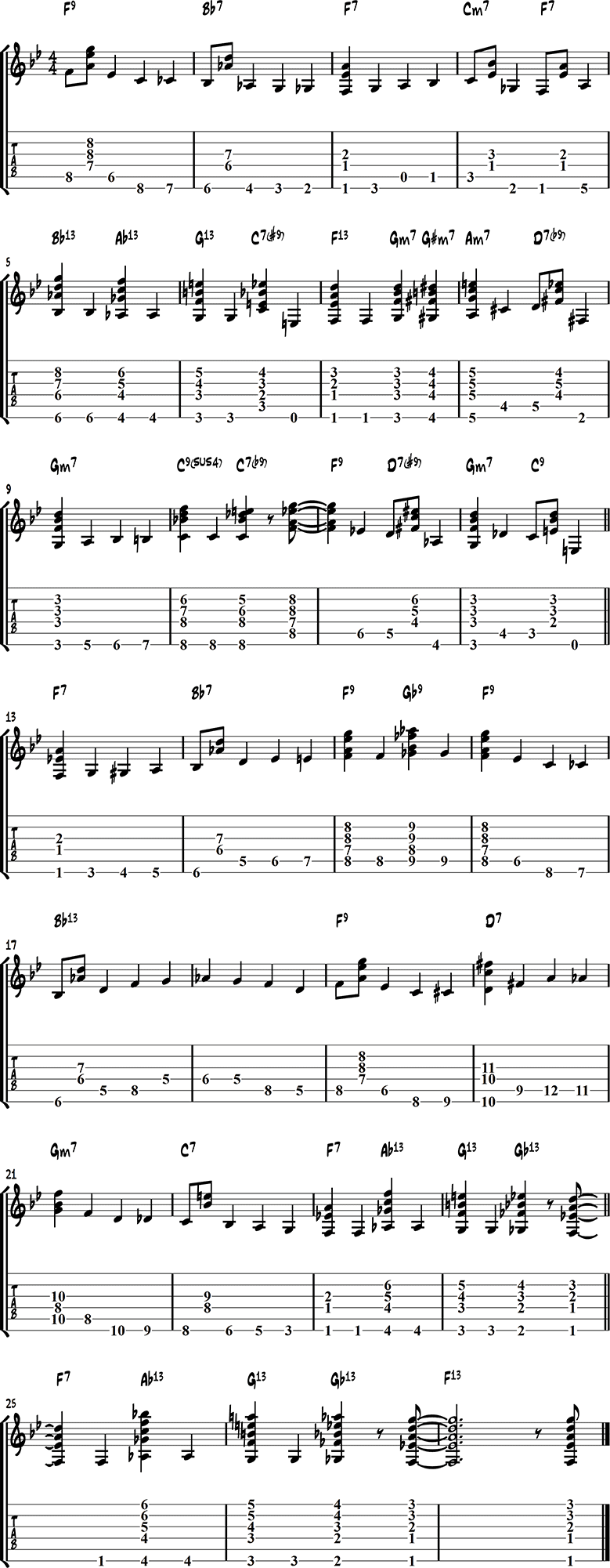
Step 1: Playing the Roots
The very start in learning how to walk a bass line is being able to play the root note of each chord on the lowest two strings (A and E strings) of the guitar.
The root note will usually be the first note of every bar throughout the entire chord sequence.
In this example, the roots of each chord are written out on the lowest two strings.
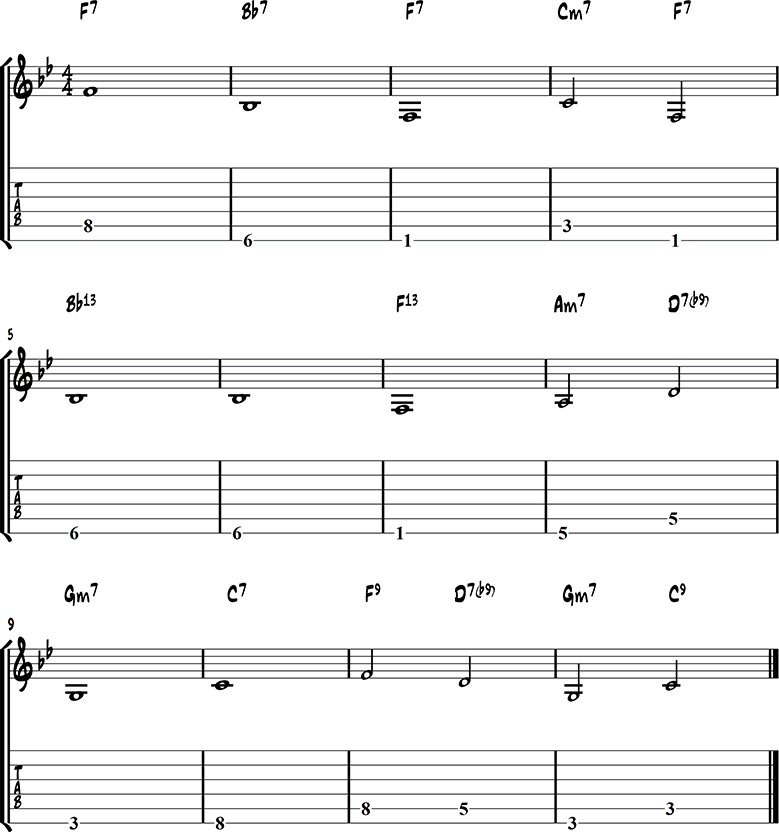
Step 2: Half Time
In the next step of constructing walking bass lines, we will play what bass players refer to as half time, where the half note is the rhythmic focus of the line.
This is done by adding a note on the third beat of each bar for a duration of two beats.
This note can either be:
- A chord tone: the 3rd, 5th, or 7th of the chord you are on. The chord tones are the most important notes to use in your bass line.
- An approach note (AN): this is a note that leads us into the next chord by either a half-step (one fret) above or below the following root. For example, if we are going to an F7 chord, the two chromatic approach notes of the target note (F) would be E (below) or Gb (above). This chromatic approach allows us to add a sense of voice leading to our bassline and immediately brings it into the jazz idiom, as chromatic tones are very common in jazz.
- A diatonic note (DN): this is a note that comes from the scale of the chord you are on, but is not a chord note.
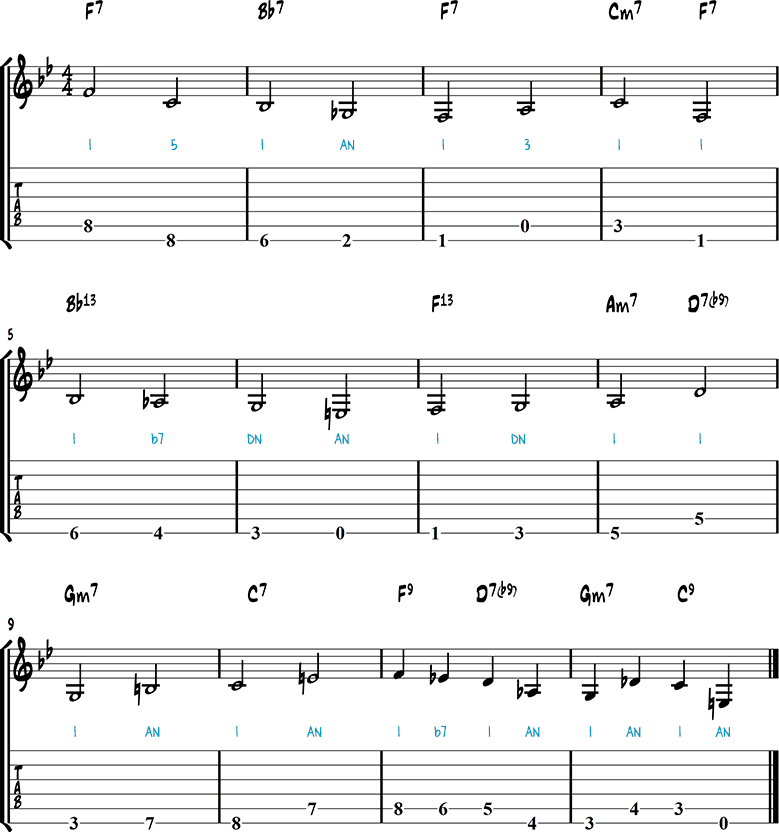
Notice that we now have a rhythmic change in the last two bars. Because the chord movement is twice as fast in these two bars we have to use quarter notes when adding our approach tones.
This leads us nicely into step 3 which will deal with what bass players refer to as walking time, where the quarter note is now the focus of the line.
Step 3: Walking the Bass
Now that we have introduced a quarter note pulse in the last two measures of example 2 we can now “walk” a bass line through the entire blues progression.
When adding the extra notes there are two things to keep in mind:
- The last note before a new chord is often an approach note, now written as a quarter note.
- We can use any note from the diatonic scale or arpeggio to fill in the remaining quarter notes.
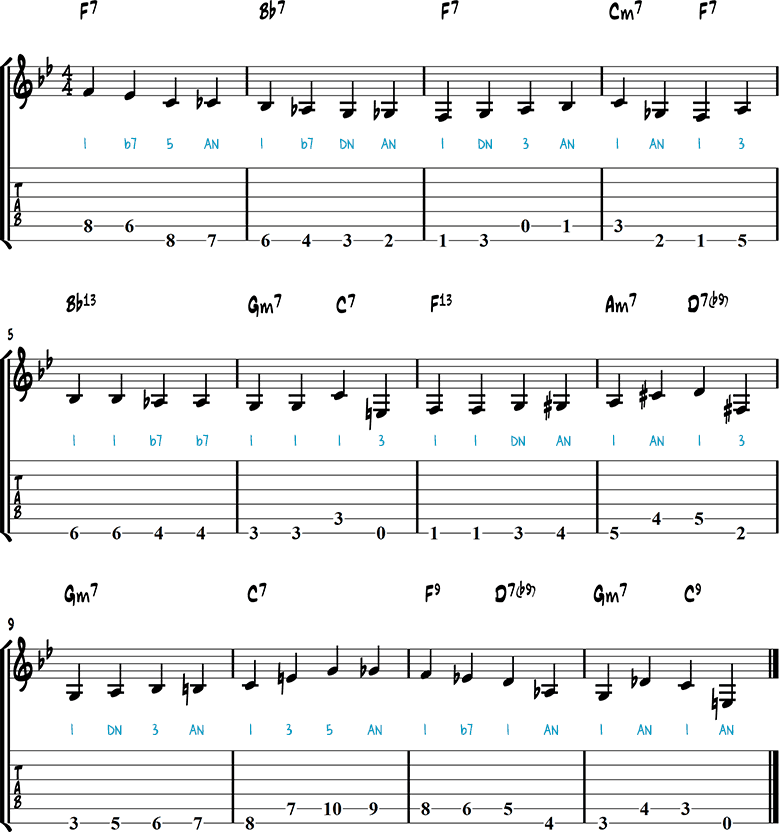
Step 4: The Chords
Now that you know how to build a walking bass line, we are ready to add some chord voicings.
Shell chords are a type of voicing that is often used in walking bass lines, but drop 2 and drop 3 chords are used as well.
Here are some easy-to-grab chord voicings that we will be using:




Step 5: Combining Walking and Comping
Now that we have the bass line and the chords under our fingers it is time to bring them both together.
The chord voicings will often appear on the “and” of the first beat (bar 1 and 2), but also on the first beat (bar 3), or the “and” of the third beat (bar 4).
This is a common rhythmic choice for guitarists who walk and comp at the same time, but again once you have this idea down feel free to put the chord in any part of the bar.

Step 6: Adding Chord Substitutions
The final step is to add some chord substitutions to the progression.
Chord Substitution 1
The first substitution occurs in bar 5 of the main example.
Instead of playing two bars of Bb7 or one bar of Bb7 and one bar of B°7, I play a descending chord progression: Bb7 to Ab7 to G7 to C7.
- Ab7 is the tritone substitution of D7, the V of G7.
- G7 – C7 is the II V back to F7. Normally this would be Gm7 – C7, but in a blues, you can make every chord into a dominant-type chord.
Chord Substitution 2
The next substitution happens in bar 10, where I delay the C7 with a C9sus4 chord.
Adding a sus chord before a dominant chord is an effective way to create more movement in your chord voicings.
Chord Substitution 3
In bar 15, I play a Gb7 after the F7.
Gb7 is the tritone substitute of C7 and is another way to create movement in the chord progression.
Chord Substitution 4
The chromatic descending line of 13th chords that starts in bar 23 is also the result of a series of tritone substitutions on the normal turnaround.
- Ab7 is the tritone substitute of D7.
- Gm7 becomes G7, as you can turn any chord in a blues into a dominant chord.
- Gb7 is the tritone substitute of C7.
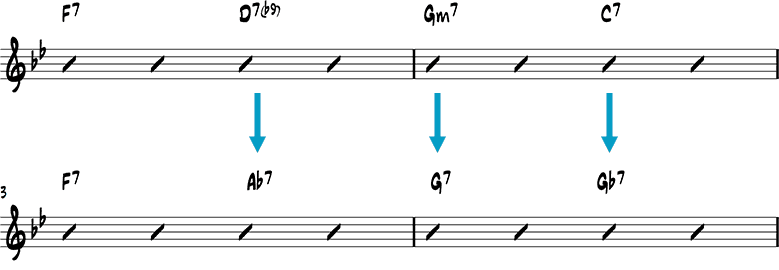
Walking Bass Line Patterns
Here is a series of walking bass line patterns ordered by chord type (major, minor, dominant, and half-diminished).
Memorizing these patterns will make it a lot easier to improvise simple walking bass lines over jazz standards.

Now we are ready to take these same steps and apply them to any jazz tune, be it a blues tune or standard 32 bar tune such as Autumn Leaves. You might want to try writing out the steps when first applying them to other tunes, and once you are proficient at writing them out try and walk/comp on the fly.
Being able to create walking basslines and fill them in with chords on the spot is a great skill to have and will definitely make you (as a guitarist) more desirable in a solo or duo situation.



Dit is geweldig! Dankjewel.
Hi Dirk
What an amazing lesson! JGO has got to be the ‘Go to’ Jazz guitar website! Please keep this website going. It is so invaluable to beginners and pros alike.
Thank you!
Dirk, love your lessons, really strong and really good methodology. Would be so great to have the GIF files, all the lessons you send out with them go straight into soundslice, which makes it so much easier to learn, sort and organize for later practice, speed up, slow down, loop and manipulate for self study in other areas. If possible, would be amazing. thank you, Jere
Hi dirk, This jazz system of yours is the best I have seen for learning jazz.
and jazz can get complicated as we all know. Your system is very well explained
and easy to follow, even for people that haven’t had much music theory.
I am an older person have played jazz numbers with a trumpet and sax
players on organ piano and guitar. I first downloaded the chord and scale
theory for my son who is starting on guitar. He is getting there slowly so
can,t push to much down his neck to quick. Anyway thank you for your
effort to put such a great Jazz learning system together. Thanks
Gran lección, muchas gracias por compartir
A walking bass line lesson! Thank you so much Dirk –
you are a STAR!
This is really outstanding. I have purchased…and love your Jazz Patterns course. This is a great bonus!
Thanks Dirk
Great lesson MMO
Best wishes
Max
Thanks a lot!!!
This is very clear and well explained. Thanks, Dirk.
Heel duidelijk, hoewel ik er nog lang niet aan toe ben, ik ben pas begonnen in chords geven deze mails een extra stimulans om door te gaan. Bedankt!
Wow you make it sound easy but harder to do.Ria
Thanks again
My head is exploding 🤯
So awesome. I have some practicing to do.
Vielen Dank, klasse erklärt.
Grazie, spiegazione eccellente, tutto ha un senso logico. Grande maestro.
Thank yo Dirk for your share, very educational.
Bellissima e interessante lezione Grazie
Excelente trabajo!!!
Muy bueno, muy útil.
Muchas gracias!!!
Quite enjoyed this walkingbass lesson and explanation. Made clear and good to follow. Thanks
Nice Lesson. Split octave subs: Ab7(-5) for D7 is very jazzy.
Très instructif une fois de plus.
The magic behind walking bass finally revealed ! Thank you very much (from France)
Wow. It seems so easy.
Very cool stuff. Thank you
Thank you Dirk. Look forward to using this. Thank you again!
Excellent!
Very sound people. Appreciate
Very nice. Love it.
¡¡¡¡¡¡¡¡¡¡¡¡¡¡EXCELENTE!!!!!!!!!!!!!!!!!!
precious as always.
What a great lesson !!!!!! Thank you.
As always a pleasure. Thanks a lot
Very educational. 10X!
Great lesson! I was waiting for it!!! Thank you!!!
Excelente lección. Muchas gracias.
Bravo maestro!
Hello Dirk,
very helpful ! I greatly value your systematic and to the point approach. And it is a topic which up to here I have never found treated in a stand-alone lesson. Thank you a lot for this and for all the other online lessons you publish and help making progress as a jazz guitarist.
Guido
Eupen/Belgium
Thank you. Very useful ! Also to learn how to play the bass, just in case.
A really great piece of work. Thank you for sharing this knowledge.
One of the better explanations/lessons on walking bass I’ve seen. Look forward to digging into this, thanks!
Ottima lezione
Terrific overview – many thanks!
Vielen Dank !!! Ganz toll umgesetzt diese Lektion…
Excelente Lección
Thanks Elias!